Table of Contents
Introduction
When you’re hitting the trails for an outdoor adventure, having the right gear is critical. Whether you’re navigating through dense forests, climbing steep mountains, or simply enjoying nature, a reliable hiking watch can be your most essential tool. These rugged devices do far more than just tell time — they can track your location, monitor your fitness, predict weather changes, and even help you navigate back to safety. If you’re serious about hiking, investing in the best watch for your adventures is a must.
But with so many options on the market, choosing the right hiking watch can be a daunting task. That’s where this guide comes in. We’ve done the research and compiled a list of the best watches for hiking that not only offer outstanding features but also fit a wide range of budgets. From advanced GPS systems to robust durability and solar charging, these watches are designed to keep you informed and safe while you explore the great outdoors.
In this in-depth guide, we’ll cover the key features to look for in a hiking watch, dive deep into product reviews, and offer expert advice to help you make the right choice. Whether you’re a seasoned hiker or just starting out, we’ve got the perfect watch for your next adventure.
Key Features to Look for in a Hiking Watch
A good hiking watch is packed with features that go beyond telling the time. Before diving into the reviews, let’s take a closer look at what you should consider when choosing the best hiking watch for your needs.
1. GPS Navigation
One of the most important features for any hiking watch is GPS navigation. Whether you’re exploring new trails or venturing into remote areas, a reliable GPS can be a lifesaver. High-end hiking watches often come with advanced GPS tracking that allows you to plot routes, set waypoints, and even retrace your steps if you get lost. Some watches also include preloaded maps for easy navigation, while others allow you to download maps before your hike.
When it comes to accuracy, not all GPS systems are created equal. Watches that use multi-satellite systems (like GPS, GLONASS, and Galileo) tend to offer better coverage, especially in challenging environments like dense forests or deep canyons. This is crucial for hikers who find themselves off the beaten path. Additionally, some hiking watches come with topographical maps that can guide you through rugged terrains, while others include turn-by-turn navigation for ease of use.
2. ABC Sensors (Altimeter, Barometer, Compass)
The ABC sensors—Altimeter, Barometer, and Compass—are vital tools for any serious hiker. These sensors provide critical information about your environment, helping you make informed decisions on the trail.
- Altimeter: Measures your altitude, which is particularly useful for mountain hiking or tracking elevation changes during your trek.
- Barometer: Monitors air pressure, helping you predict weather changes. A sudden drop in pressure can indicate an incoming storm, giving you a heads-up to find shelter.
- Compass: Ensures that you stay on course, even if you’re navigating off-trail or in an area with limited visibility.
Many hiking watches integrate these sensors to provide real-time data, making them essential for anyone hiking in unpredictable weather or unfamiliar terrain.
3. Durability and Water Resistance
Hiking watches need to withstand tough conditions. Look for a watch with a rugged design, typically made from materials like titanium, stainless steel, or reinforced resin. Some watches even come with military-grade certifications for durability, ensuring they can survive drops, shocks, and extreme temperatures.
Water resistance is another crucial factor. Even if you don’t plan on swimming with your watch, hiking often involves exposure to rain, rivers, and sweat. A water resistance rating of at least 50 meters (5 ATM) is a good starting point, but for more adventurous hikers, a rating of 100 meters or more is recommended.
4. Battery Life and Solar Charging
Battery life is a make-or-break feature for many hikers, especially those embarking on multi-day trips. Hiking watches with GPS functionality tend to drain their batteries quickly, so it’s important to find a watch that can last through your entire hike. Some models offer battery-saving modes that can extend usage by limiting certain features, while others provide solar charging capabilities, allowing you to recharge on the go.
For instance, solar-powered hiking watches can convert sunlight into energy, keeping your watch operational even on long hikes far from a power source. This feature is invaluable for thru-hikers or anyone spending extended time in the wilderness.
5. Heart Rate Monitoring and Fitness Tracking
Keeping track of your physical performance is essential, especially on demanding hikes. Many hiking watches come with heart rate monitors to track your exertion levels in real-time. Advanced watches can even provide data on your VO2 max (a measure of your oxygen consumption during exercise), calorie burn, and recovery times.
For fitness enthusiasts, some hiking watches also offer additional features like step counting, sleep tracking, and stress monitoring, making them versatile tools for both health and hiking.
6. Connectivity Features (Smart Notifications, SOS Alerts)
While the primary function of a hiking watch is to assist you on the trail, many models now include smart features like call and message notifications, music controls, and even contactless payments. While these may not be essential for everyone, they can add convenience to your hiking experience.
More importantly, some hiking watches come with SOS alert features that can automatically send your location to emergency contacts if you find yourself in trouble. This feature could be invaluable in the event of an accident or sudden health issue on the trail.
Best High-End Hiking Watches
For hikers who want the best of the best, these premium watches offer top-of-the-line features, durability, and performance. These watches are perfect for extreme outdoor enthusiasts who need advanced tools for navigation, fitness tracking, and safety.
1. Garmin Fenix 7X Solar

The Garmin Fenix 7X Solar is one of the most advanced hiking watches on the market, packed with features that make it perfect for serious hikers. Its solar charging capability allows you to extend battery life, making it ideal for multi-day hikes or long expeditions where access to power is limited.
With its multi-GNSS support, including GPS, GLONASS, and Galileo, the Fenix 7X Solar provides incredibly accurate navigation, even in remote areas. The watch also features topographical maps, route planning, and turn-by-turn navigation, making it easy to explore new trails without getting lost.
In terms of durability, the Fenix 7X Solar is built to withstand harsh conditions. It’s water-resistant up to 100 meters, has a rugged design, and is equipped with scratch-resistant sapphire crystal. Additionally, it comes with ABC sensors (Altimeter, Barometer, Compass), heart rate monitoring, and Pulse Ox (which measures your blood oxygen levels).
Pros
Cons
2. Suunto 9 Baro
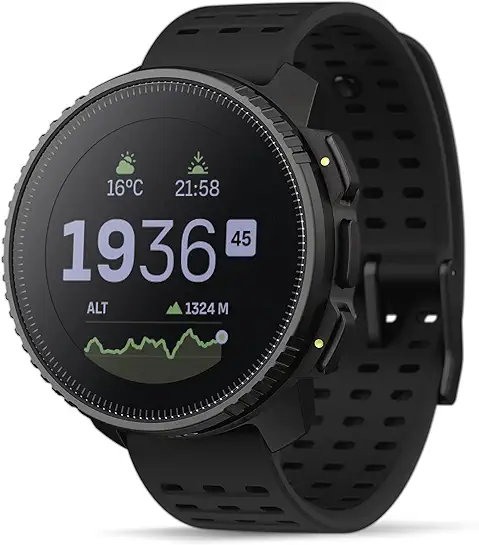
The Suunto 9 Baro is another top-tier option, known for its long battery life and accurate tracking features. One of its standout features is FusedTrack technology, which combines GPS data with motion sensor information to enhance tracking accuracy while conserving battery life. This makes it an excellent choice for long hikes or ultra-endurance adventures.
Like the Fenix 7X, the Suunto 9 Baro comes with multi-GNSS support, offering reliable navigation in challenging environments. It also includes a storm alarm, which alerts you to sudden changes in barometric pressure, giving you time to find shelter before bad weather hits.
The watch is built to endure tough conditions, with military-grade durability and water resistance up to 100 meters. Its ABC sensors are highly accurate, making it easy to monitor altitude changes, track weather conditions, and stay on course.
Pros
Cons
3. Coros Vertix 2

If you’re looking for a hiking watch with exceptional battery life, the Coros Vertix 2 is hard to beat. It offers up to 140 hours of GPS tracking in its standard mode, making it a favorite among ultra-endurance athletes and serious hikers who need their watch to last for days on end.
The Vertix 2 features dual-frequency GNSS satellite systems, providing some of the most accurate GPS tracking available, even in the most remote and challenging environments. This makes it an excellent choice for backcountry hikers or anyone exploring off-trail.
In addition to its GPS capabilities, the Vertix 2 is designed for extreme conditions. It’s water-resistant up to 150 meters and can withstand temperatures as low as -4°F (-20°C). The watch also features a heart rate monitor, blood oxygen sensor, and recovery time recommendations, making it a versatile tool for both hiking and fitness.
Pros
Cons
Best Mid-Range Hiking Watches
For those who want a balance of features and affordability, these mid-range hiking watches offer great value without compromising too much on performance.
1. Garmin Instinct Solar

The Garmin Instinct Solar is a fantastic mid-range option that offers many of the features found in Garmin’s high-end models, but at a more affordable price. One of its standout features is its solar charging capability, which can significantly extend the battery life, especially when you’re outdoors in sunny conditions.
The Instinct Solar comes with multi-GNSS support, making it easy to navigate in challenging environments. It also features ABC sensors, heart rate monitoring, and a Pulse Ox sensor for tracking blood oxygen levels.
In terms of durability, the Instinct Solar is built to last. It’s MIL-STD-810G certified for thermal, shock, and water resistance (up to 100 meters), making it a great choice for rugged adventures.
Pros
Cons
2. Polar Grit X
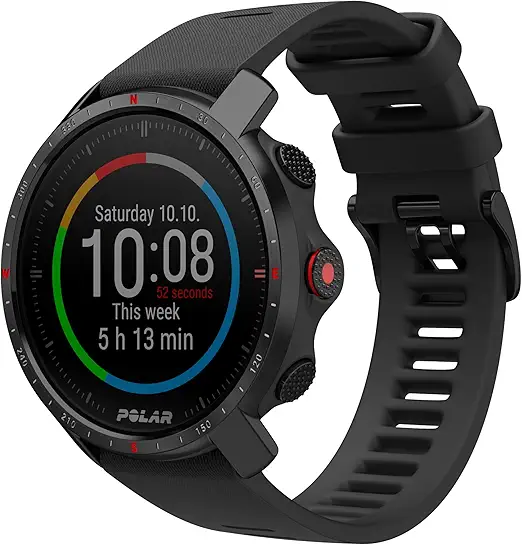
The Polar Grit X is another excellent mid-range hiking watch that offers a great balance of features for outdoor enthusiasts. One of its most unique features is Hill Splitter, which tracks your performance on both ascents and descents, making it perfect for hikers who tackle mountainous terrain.
The Grit X also offers FuelWise, a feature that helps you manage your energy levels during long hikes by providing reminders to refuel based on your activity. It comes with GPS tracking, ABC sensors, and heart rate monitoring, giving you all the tools you need to stay on track and monitor your fitness.
In terms of durability, the Grit X is built to withstand tough conditions. It’s water-resistant up to 100 meters and has been tested to military standards for shock and thermal resistance.
Pros
Cons
3. Suunto 5 Peak
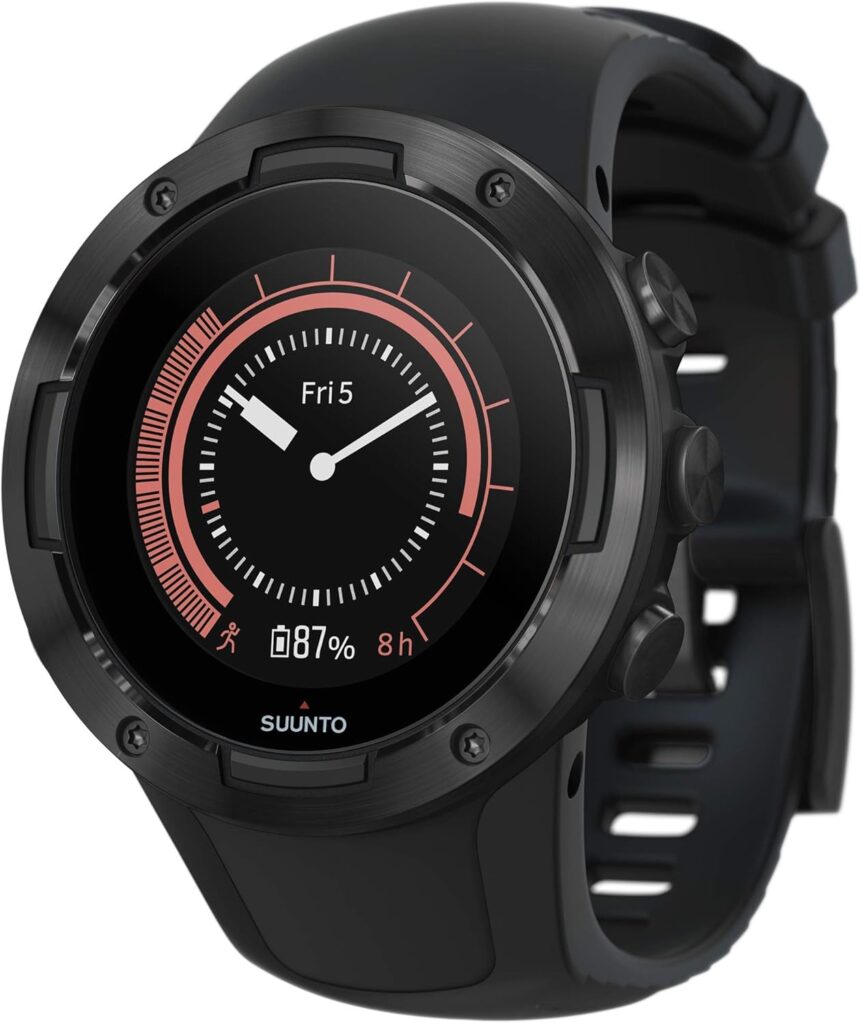
The Suunto 5 Peak is a lightweight, affordable option that still packs a punch in terms of features. It offers GPS tracking, heart rate monitoring, and a stress and recovery tracker, making it a versatile tool for both hiking and fitness.
The Suunto 5 Peak’s battery life is impressive, with up to 100 hours of use in its power-saving mode. It’s also water-resistant up to 30 meters, making it suitable for light water exposure. While it doesn’t offer the advanced features found in high-end models, it’s a solid choice for casual hikers who want a reliable, affordable watch.
Pros
Cons
Best Budget-Friendly Hiking Watches
If you’re looking for a reliable hiking watch without breaking the bank, these budget-friendly options offer great value and essential features for outdoor adventures.
1. Casio Pro Trek PRG-270-1
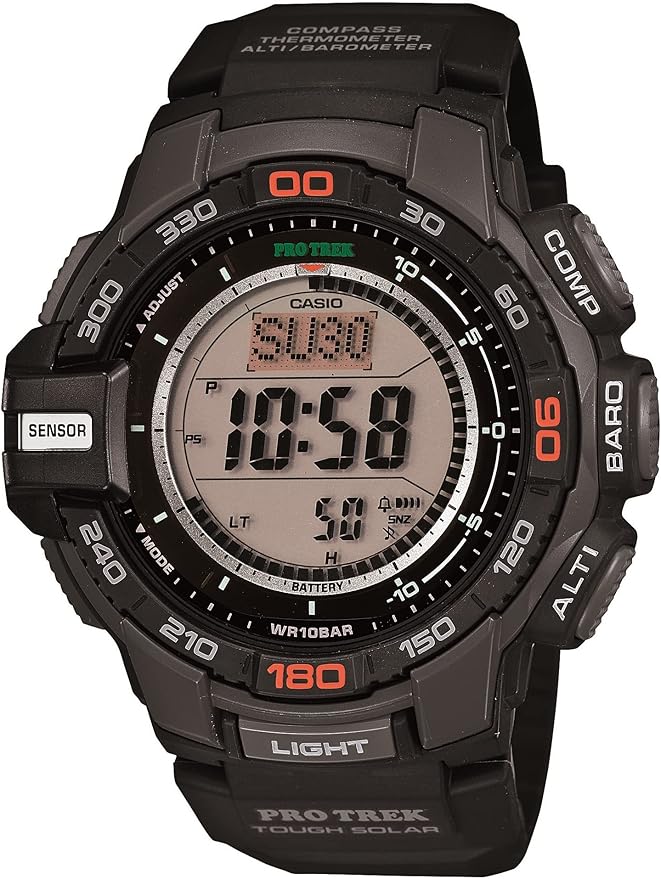
The Casio Pro Trek PRG-270-1 is a rugged, budget-friendly option that’s perfect for beginner hikers. It features solar power, so you won’t have to worry about battery life, and it comes with ABC sensors (Altimeter, Barometer, Compass) for basic navigation and weather tracking.
While it doesn’t offer GPS tracking, the Pro Trek is still a great choice for those who need a durable, reliable watch for hiking in less remote areas. Its 100-meter water resistance makes it suitable for all types of weather conditions.
Pros
Cons
2. Timex Expedition Shock XL

The Timex Expedition Shock XL is another great budget option that offers excellent durability at an affordable price. It’s shock-resistant to ISO standards and water-resistant up to 200 meters, making it perfect for rugged outdoor adventures.
While it lacks advanced features like GPS or heart rate monitoring, the Expedition Shock XL is a reliable, no-frills hiking watch that’s perfect for those who want something simple yet durable.
Pros
Cons
3. Amazfit T-Rex Pro
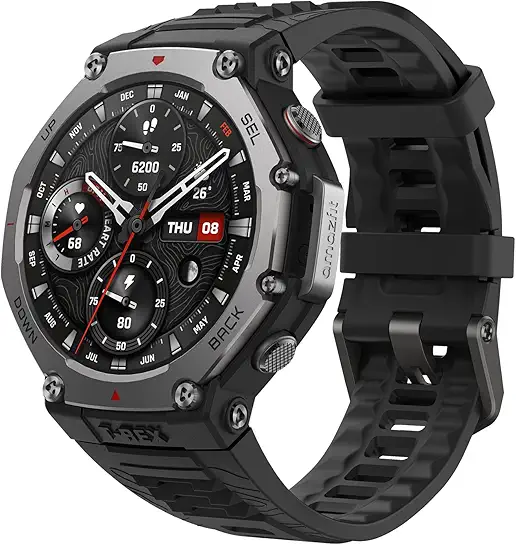
The Amazfit T-Rex Pro is a surprising contender in the budget category, offering a wide range of features typically found in more expensive watches. It comes with GPS tracking, heart rate monitoring, and even 14 sports modes, making it a versatile option for hikers and fitness enthusiasts alike.
The T-Rex Pro is also MIL-STD-810G certified for durability and water-resistant up to 100 meters, making it a great choice for rugged adventures. While it doesn’t offer the same level of mapping and navigation features as high-end models, it’s an excellent value for the price.
Pros
Cons
Hiking Watch Comparisons
Premium vs. Budget Hiking Watches
When deciding between a premium and budget hiking watch, it’s important to consider your specific needs. Premium watches like the Garmin Fenix 7X Solar and Suunto 9 Baro offer advanced GPS systems, topographical maps, and multi-satellite support, making them ideal for hikers who explore remote or challenging environments. These watches also come with features like heart rate monitoring, solar charging, and durability certifications, ensuring they can handle the toughest conditions.
On the other hand, budget watches like the Casio Pro Trek and Timex Expedition Shock XL are great for casual hikers who don’t need advanced features like GPS or fitness tracking. These watches are durable, reliable, and affordable, making them perfect for beginners or those who stick to well-marked trails.
| Feature | Premium (Garmin Fenix 7X Solar) | Budget (Casio Pro Trek PRG-270-1) |
|---|---|---|
| GPS | Yes, multi-GNSS support | No |
| ABC Sensors | Yes | Yes |
| Battery Life | Long with solar charging | Long with solar power |
| Water Resistance | 100 meters | 100 meters |
| Durability | Military-grade | Standard durability |
How to Maintain Your Hiking Watch
To ensure your hiking watch lasts for years to come, it’s important to take proper care of it. Here are a few tips on how to maintain your watch:
- Clean the watch regularly: After a hike, especially in dusty or muddy environments, clean your watch with a soft cloth and mild soap to remove any dirt or debris. Be sure to avoid harsh chemicals that could damage the watch’s finish or water-resistant seals.
- Avoid extreme temperatures: While many hiking watches are designed to withstand harsh conditions, it’s best to avoid exposing them to extreme heat or cold for prolonged periods. This can help maintain the integrity of the battery and the overall performance of the watch.
- Use screen protectors and replacement straps: For added protection, consider using a screen protector to prevent scratches on the display. If your watch comes with replaceable straps, make sure to use durable ones that can handle rough conditions.
- Properly charge your watch: If your watch has a rechargeable battery, avoid letting it fully discharge before recharging. Keeping your battery topped up can help prolong its lifespan, especially for solar-powered models.
Real-Life Hiking Scenarios: How a Watch Made a Difference
To illustrate the importance of a good hiking watch, here are a few real-life stories from hikers who’ve used their watches to improve their safety and experience on the trail.
Story 1: Avoiding a Storm with the Garmin Fenix 7X Solar John, an experienced hiker, was trekking through the Rocky Mountains when his Garmin Fenix 7X Solar alerted him to a sudden drop in barometric pressure. Realizing that a storm was on the way, John decided to set up camp early and avoid the worst of the weather. Thanks to the watch’s barometer, he was able to stay safe and dry, even as heavy rain and strong winds battered the area.
Story 2: Retracing Steps with the Suunto 9 Baro Sarah was hiking in a dense forest when she realized she had taken a wrong turn and couldn’t find her way back to the trail. Fortunately, her Suunto 9 Baro had been tracking her route using GPS, and she was able to retrace her steps back to the main trail. Without the watch’s GPS tracking, she could have been lost for hours.
Story 3: Monitoring Altitude in the Himalayas with the Coros Vertix 2 Tom was trekking at high altitudes in the Himalayas when he started feeling symptoms of altitude sickness. Using the Coros Vertix 2‘s altimeter and Pulse Ox sensor, Tom monitored his oxygen levels and noticed they were dropping quickly as he ascended. Thanks to the watch’s data, he made the decision to descend to a lower altitude before his condition worsened, ultimately avoiding a serious health issue.
Conclusion:
When it comes to selecting the best hiking watch, it ultimately depends on your personal needs, hiking habits, and budget. If you’re a seasoned adventurer exploring remote and challenging environments, investing in a premium watch like the Garmin Fenix 7X Solar or Suunto 9 Baro is well worth the price for their advanced features and durability. For casual hikers or those just starting out, budget-friendly options like the Casio Pro Trek PRG-270-1 or Timex Expedition Shock XL offer essential features at a fraction of the cost.
Regardless of which model you choose, a reliable hiking watch can significantly enhance your outdoor experience, helping you navigate, stay safe, and monitor your fitness levels along the way. Be sure to consider factors like battery life, GPS capabilities, durability, and budget before making your purchase, and you’ll find a hiking watch that perfectly suits your adventure needs.
FAQs
What watch do you wear for hiking?
The best watch for hiking depends on the terrain, duration of the hike, and your personal needs. For casual hikers, a basic watch like the Casio Pro Trek PRG-270-1 with ABC (Altimeter, Barometer, Compass) sensors is a great choice for navigating trails without GPS. For more advanced hikers, watches like the Garmin Fenix 7X Solar or Suunto 9 Baro offer advanced GPS tracking, topographical maps, heart rate monitoring, and rugged durability, perfect for tackling remote or challenging terrain.
Is Garmin good for hiking?
Yes, Garmin watches are widely regarded as some of the best for hiking. Models like the Garmin Fenix 7X Solar and Garmin Instinct Solar are designed with outdoor adventurers in mind, offering features like multi-GNSS GPS tracking, topographic maps, ABC sensors, and solar charging for extended battery life. Garmin’s robust, durable design, combined with advanced navigation and fitness features, make them ideal for both casual and experienced hikers.
Do you need a GPS watch for hiking?
A GPS watch is not absolutely necessary for hiking, but it can be incredibly helpful, especially if you are hiking in remote areas or unfamiliar terrain. GPS watches provide accurate location tracking, allowing you to navigate more easily and even retrace your steps if you get lost. For short or well-marked hikes, a non-GPS watch with ABC sensors like the Casio Pro Trek may be sufficient. However, for longer, more remote hikes, investing in a GPS watch like the Garmin Fenix 7X Solar or Suunto 9 Baro can significantly improve your safety and navigation.